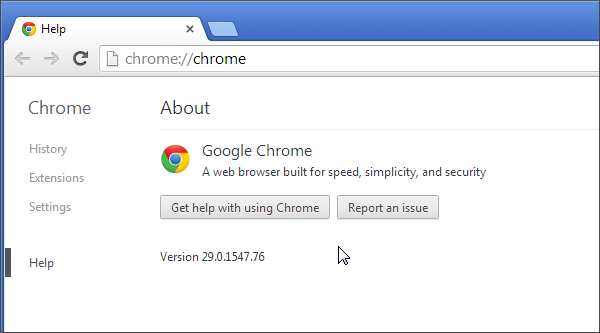Posted by on August 20, 2013
Today Chrome 29 was released and we just added it to our browser testing cloud. You can start testing your websites in this new browser version on Mac, Windows and Linux today!

Try Chrome 29 in Browserling now!
Chrome 29 Key Changes
- Improved Omnibox suggestions based on the recency of sites you have visited.
- Ability to reset your profile back to its original state.
- Many new apps and extensions APIs.
- Lots of stability and performance improvements.
All Chrome 29 Changes
- Support for VP9 final added.
- Support for TLS 1.2 added.
- Preliminary QUIC support added.
- Improved Omnibox suggestions based on the recency of visited sites.
- Ability to reset user profile back to its original state.
- New apps and extensions APIs (such as Native Messaging API for connecting Chrome with native applications installed on the same computer, which is an alternative to NPAPI).
- WebRTC support (Android).
- WebAudio support (Android).
- Improved scrolling responsiveness and visual indication when scrolling to the top or bottom of a page (Android).
- Startup performance and stability improvements (Android).
- New color picker user interface for web forms (Android).
- Support for Google's experimental data compression service (comparable to Opera Turbo) that lets Google servers quickly read and optimize a Web page for mobile devices, then transmit it to the smartphone using Google's SPDY network technology (Android).
- Rudimentary tab groups implemented (Android).
- Get back to Search Results faster (iOS).
- Data cost savings enhancements (iOS).
- Voice search pronoun support, for example, queries like: "Who is the richest person in the World" followed by "When was he born?" (iOS).
- Improvements to Single Sign On with other Google Apps (iOS).
- Support for WebP image format (iOS).
Chrome 29 Developer Changes
- CSS: CSS Device Adaptation - The
@viewportrule, in combination with media queries, enabled web developers to optimize the layout of sites and apps for different devices with minimal effort. It generalizes the viewport meta tag to CSS, while being much simpler to understand and without the quirks that exists with the meta tag. - CSS: Media Queries: resolution feature - Allows to query the device pixel count per CSS unit.
- CSS: Deprecate
overflowvalue - Proprietary marquee valueoverflow: -webkit-marqueeis now deprecated. - Network/Connectivity: QUIC - An experimental, UDP-based QUIC transport protocol.
- Misc: Sending Messages to Extensions - Expose a Chrome-specific API to allow websites to send messages to extensions. Only exposed to websites whitelisted by an installed extension.
- Network/Connectivity: TLS 1.2 - The latest version of the Transport Layer Security (TLS) protocol. Uses asymmetric cryptography to assure who is communicating, and to exchange a symmetric key. This session key is then used to encrypt data flowing between the parties. This allows for data/message confidentiality, and message authentication codes for message integrity and as a by-product message authentication.
- Multimedia: VP9 - VP9 is an open and royalty free video compression standard.
- Network/Connectivity: XMLHttpRequest timeout - Exposing the XHR timeout property and sending corresponding events such as ontimeout.
Chrome 29 Security Fixes
Chrome 29 release includes 25 security fixes, including:
- CVE-2013-2900: Incomplete path sanitization in file handling. Credit to Krystian Bigaj.
- CVE-2013-2905: Information leak via overly broad permissions on shared memory files. Credit to Christian Jaeger.
- CVE-2013-2901: Integer overflow in ANGLE. Credit to Alex Chapman.
- CVE-2013-2902: Use after free in XSLT. Credit to cloudfuzzer.
- CVE-2013-2903: Use after free in media element. Credit to cloudfuzzer.
- CVE-2013-2904: Use after free in document parsing. Credit to cloudfuzzer.
Happy cross-browser testing in Chrome 29!
Email this blog post to your friends or yourself!
Try Browserling!
Enter a URL to test, choose platform, browser and version, and you'll get a live interactive browser in 5 seconds!



 Subscribe to updates!
Subscribe to updates!
 BizSpark
BizSpark